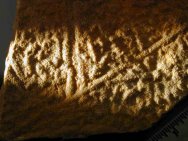 The
fossil record provides scant evidence of the temporal scenario
of the transition of metazoans to life on land. The oldest fossil
of an animal that putatively lived on land is a euthycarcinoid
from the late Ordovician of Australia. The oldest terrestrial
faunal assemblages are arachnids and myriapods from the Silurian
of UK. Except for some late ichnofossils, the fossil record
provides no evidence to set aside the hypothesis that prokaryotes
ruled the land to the end of the Cambrian and many millions
of years beyond. Of particular importance are ichnofossils of
the genus
The
fossil record provides scant evidence of the temporal scenario
of the transition of metazoans to life on land. The oldest fossil
of an animal that putatively lived on land is a euthycarcinoid
from the late Ordovician of Australia. The oldest terrestrial
faunal assemblages are arachnids and myriapods from the Silurian
of UK. Except for some late ichnofossils, the fossil record
provides no evidence to set aside the hypothesis that prokaryotes
ruled the land to the end of the Cambrian and many millions
of years beyond. Of particular importance are ichnofossils of
the genus 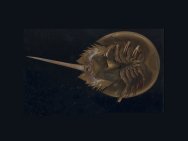 Protichnites,
which occur in several North American locations dating from
the late Cambrian into the Ordovician.
Protichnites,
which occur in several North American locations dating from
the late Cambrian into the Ordovician.
The
Protichnites ichnogenera generally refers to a trackway
with two
rows of imprints (footprints) inside which is a medial impression
(such as a telson drag mark). They
occur throughout the Paleozoic, throughout the world. Notable
Protichnites sites occur in Ontario, Quebec, New York, and
Missouri, and all in subtidal, intertidal and/or eolian
(i.e., as in dunes above the tide line) sandstones. Among
these sites, the Protichnites from the Krukowski Quarry
are the oldest at some 510 million years ago. Arthropods
underwent enormous change and numerous radiations throughout
the periods of the Cambrian. It is likely that the makers
of the Protichnites (and Diplichnites) ichnogenus also had
many arthropod makers that changed across geologic time.
But what animals made the upper Cambrian tracks found in
the Krukowski quarry. The main suspects are eurypterids, horseshoe
crabs, Euthycarcinoids
and the Aglaspids, or some closely related arthropod
or stem group among these taxons.
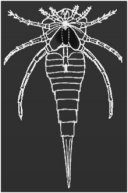 It
was a time when evolutionary adaptation was producing predators,
and a time when adaptation was producing defense from predation,
both powerful selective pressures in part fueling what is known
as the Cambrian explosion. It is reasonable then to conjecture
that animals found ways to first emerge on marine shorelines
for different reasons -- some to graze in safety on abundant
bacterial colonies, and possibly others to hunt the grazers.
It
was a time when evolutionary adaptation was producing predators,
and a time when adaptation was producing defense from predation,
both powerful selective pressures in part fueling what is known
as the Cambrian explosion. It is reasonable then to conjecture
that animals found ways to first emerge on marine shorelines
for different reasons -- some to graze in safety on abundant
bacterial colonies, and possibly others to hunt the grazers.
The
animal that made Protichnites tracks could have been one of
the Earth's first air-breathing animals. The Protichnites ichnogenus
is a Repichnia Ichnofossil associated
with vagile locomotion. Sir William Logan described the Protichnites
genus in 1863, the time of Darwin,
as fossil evidence that animals had evolved more rapidly and
much earlier than thought at the time of its discovery. Notable
in Protichnites is the prominent markings of a tail or other
body part being dragged; footprints, when present, are subtle
by comparison. The maker of these fossil trackways might have
been an animal
resembling the extant but ancient horseshoe crab, except of
a stem 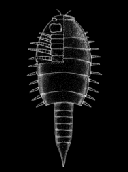 group
that lacked a hard shell to be preserved. Others have posited
that Protichnites was a soft-bodied progenitor of the large,
now extinct group of early predators, the Eurypterids (Chelicerate
"meaning biting claws" Arthropods). The "Eurypterid
theory" is particularly intriguing since it would imply
that just as animals were first moving to land to feed, hungry
new predators were already on the hunt.
group
that lacked a hard shell to be preserved. Others have posited
that Protichnites was a soft-bodied progenitor of the large,
now extinct group of early predators, the Eurypterids (Chelicerate
"meaning biting claws" Arthropods). The "Eurypterid
theory" is particularly intriguing since it would imply
that just as animals were first moving to land to feed, hungry
new predators were already on the hunt.
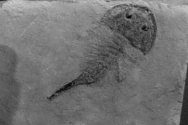 Some
of the mystery of Protichnites trackways is just being cleared
up as, after more than a decade, the very first body fossils
of a putative Protichnites track maker have at last been
discovered
in the Krukowski quarry. The creatures that were discovered
in a single dessication zone during the summer of 2003 have
affinity to some of the most problematic groups of Arthropods,
the Euthycarcinoids and the
Aglaspids.
The euthycarcinoids that are
known from 13 species from Upper Cambrian or Lower Silurian-Middle
Triassic from Argentina, Western Australia, Europe (e.g., the
Rhynie chert) and the Mazon Creek in Illinois (Vacarri, 2004).
Similarly, the aglaspids are
arthropods whose taxonomy among arthropods is uncertain. But
it is only in the Argentina and Wisconsin sites that the Protichnites
trackways are also found. The Blackberry Hill
arthropods may emerge as the oldest land-based animal fossils
in the entire
fossil record.
Some
of the mystery of Protichnites trackways is just being cleared
up as, after more than a decade, the very first body fossils
of a putative Protichnites track maker have at last been
discovered
in the Krukowski quarry. The creatures that were discovered
in a single dessication zone during the summer of 2003 have
affinity to some of the most problematic groups of Arthropods,
the Euthycarcinoids and the
Aglaspids.
The euthycarcinoids that are
known from 13 species from Upper Cambrian or Lower Silurian-Middle
Triassic from Argentina, Western Australia, Europe (e.g., the
Rhynie chert) and the Mazon Creek in Illinois (Vacarri, 2004).
Similarly, the aglaspids are
arthropods whose taxonomy among arthropods is uncertain. But
it is only in the Argentina and Wisconsin sites that the Protichnites
trackways are also found. The Blackberry Hill
arthropods may emerge as the oldest land-based animal fossils
in the entire
fossil record.
 The
most recent discovery from the Blackberry Hill Mount Elk
Group (Wisconsin) is the new species,
Protichnites eremita (described in 2009), that Hagadorn and
Seilacher hypothsize was formed by so called hermite arthropods
walked the Cambrian shore partially inside borrowed shells
of other animals; such a hermite crab-like strategy might
have
afforded the protection of a humid chamber that mitigated dessication
of gills in the alien subaerial environment. The defining
characteristic
of Protichnites eremita is tail impressions that are angled
to the left side of the track, as would be formed by a coiled
shell intermittently scraping the sediment substrate. Most
recently, Collette, et. al. (2010 and 2012) have described
arthropod body fossil casts, with legs and segmentation from
Blackberry Hill, and other studies that lends weight of evidence
to
euthycarcinoid origins to Protichnites from Blackberry Hill.
The presence of abundant sand stromatolites both above and
below the tracks
suggest that cyanobacterial mats mediated the preservation
of Protichnites eremita in the same manner as Climactichnites
ichnofossils at the same site. Diplichites trackways,
lacking parallel drag marks, suggest footprints
made deeper
in the
macrobial mats that survived erosion that the upper upper
part of the mat layer did not.
The
most recent discovery from the Blackberry Hill Mount Elk
Group (Wisconsin) is the new species,
Protichnites eremita (described in 2009), that Hagadorn and
Seilacher hypothsize was formed by so called hermite arthropods
walked the Cambrian shore partially inside borrowed shells
of other animals; such a hermite crab-like strategy might
have
afforded the protection of a humid chamber that mitigated dessication
of gills in the alien subaerial environment. The defining
characteristic
of Protichnites eremita is tail impressions that are angled
to the left side of the track, as would be formed by a coiled
shell intermittently scraping the sediment substrate. Most
recently, Collette, et. al. (2010 and 2012) have described
arthropod body fossil casts, with legs and segmentation from
Blackberry Hill, and other studies that lends weight of evidence
to
euthycarcinoid origins to Protichnites from Blackberry Hill.
The presence of abundant sand stromatolites both above and
below the tracks
suggest that cyanobacterial mats mediated the preservation
of Protichnites eremita in the same manner as Climactichnites
ichnofossils at the same site. Diplichites trackways,
lacking parallel drag marks, suggest footprints
made deeper
in the
macrobial mats that survived erosion that the upper upper
part of the mat layer did not.
Also
see: Ichnofossil Nomenclature
References





